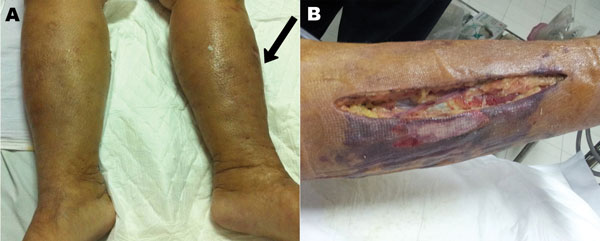Shewanella Haliotis on:
[Wikipedia]
[Google]
[Amazon]
''Shewanella haliotis'', a species of
 The route of ''Shewanella'' infection is associated with direct contact with the organism through seawater or ingestion of raw seafood, causing severe soft tissue infection. One case of infection was found to be susceptible to
The route of ''Shewanella'' infection is associated with direct contact with the organism through seawater or ingestion of raw seafood, causing severe soft tissue infection. One case of infection was found to be susceptible to
Type strain of ''Shewanella haliotis'' at Bac''Dive'' - the Bacterial Diversity Metadatabase
Alteromonadales Bacteria described in 2007 {{Alteromonadales-stub
rod-shaped
Bacterial cellular morphologies are the shapes that are characteristic of various types of bacteria and often key to their identification. Their direct examination under a light microscope enables the classification of these bacteria (and archae ...
, Gram-negative
Gram-negative bacteria are bacteria that, unlike gram-positive bacteria, do not retain the crystal violet stain used in the Gram staining method of bacterial differentiation. Their defining characteristic is that their cell envelope consists ...
, facultatively anaerobic bacteria, was first isolated from the gut microflora of abalone
Abalone ( or ; via Spanish , from Rumsen language, Rumsen ''aulón'') is a common name for any small to very large marine life, marine gastropod mollusc in the family (biology), family Haliotidae, which once contained six genera but now cont ...
(large edible sea snails) collected from the ocean near Yeosu, South Korea, by Kim ''et al.'' in 2007. Further studies showed the cells to be catalase- and oxidase-positive. The species epithet ''haliotis'' is a reference to the genus name of abalone, ''Haliotis
''Haliotis'', common name abalone, is the only genus in the family Haliotidae.
This genus once contained six subgenera. These subgenera have become alternate representations of ''Haliotis''. The genus consists of small to very large, edible, ...
''.
The genus ''Shewanella
''Shewanella'' is the sole genus included in the marine bacteria family Shewanellaceae. Some species within it were formerly classed as '' Alteromonas''. ''Shewanella'' consists of facultatively anaerobic Gram-negative rods, most of which are fou ...
'' had been previously named in 1985 by MacDonell and Colwell in honor of Scottish microbiologist James M. Shewan, for his work in fisheries microbiology.
Characteristics
A sample colony of ''S. haliotis'' was isolated from an abalone. It was pink-orange in colour, grew at 42 °C in the pH range 5–11 (with optimum pH being 7). It was found to be positive for malate as a carbon source, and negative formannose
Mannose is a sugar with the formula , which sometimes is abbreviated Man. It is one of the monomers of the aldohexose series of carbohydrates. It is a C-2 epimer of glucose. Mannose is important in human metabolism, especially in the glycosylatio ...
and glucose
Glucose is a sugar with the Chemical formula#Molecular formula, molecular formula , which is often abbreviated as Glc. It is overall the most abundant monosaccharide, a subcategory of carbohydrates. It is mainly made by plants and most algae d ...
use. The strain was resistant to both penicillin
Penicillins (P, PCN or PEN) are a group of beta-lactam antibiotic, β-lactam antibiotics originally obtained from ''Penicillium'' Mold (fungus), moulds, principally ''Penicillium chrysogenum, P. chrysogenum'' and ''Penicillium rubens, P. ru ...
and vancomycin
Vancomycin is a glycopeptide antibiotic medication used to treat certain bacterial infections. It is administered intravenously ( injection into a vein) to treat complicated skin infections, bloodstream infections, endocarditis, bone an ...
.
Human pathologies
 The route of ''Shewanella'' infection is associated with direct contact with the organism through seawater or ingestion of raw seafood, causing severe soft tissue infection. One case of infection was found to be susceptible to
The route of ''Shewanella'' infection is associated with direct contact with the organism through seawater or ingestion of raw seafood, causing severe soft tissue infection. One case of infection was found to be susceptible to ciprofloxacin
Ciprofloxacin is a fluoroquinolone antibiotic used to treat a number of bacterial infections. This includes bone and joint infections, intra-abdominal infections, certain types of infectious diarrhea, respiratory tract infections, skin ...
(0.25 mg/L), piperacillin-tazobactam (1.0 mg/L), ceftriaxone
Ceftriaxone, sold under the brand name Rocephin, is a third-generation cephalosporin antibiotic used for the treatment of a number of bacterial infections. These include middle ear infections, endocarditis, meningitis, pneumonia, bone and joi ...
(1.0 mg/L), and meropenem
Meropenem, sold under the brand name Merrem among others, is an intravenous carbapenem antibiotic used to treat a variety of bacterial infections. Some of these include meningitis, intra-abdominal infection, pneumonia, sepsis, and anthrax.
C ...
(0.38 mg/L). The patient had fever for the first 2 days of hospitalization. After 2 weeks of treatment, the antimicrobial drug was switched to oral ciprofloxacin; treatment was continued after dressing and debridement of the fasciotomy wound.
References
''Contains public domain text from the CDC''External links
Type strain of ''Shewanella haliotis'' at Bac''Dive'' - the Bacterial Diversity Metadatabase
Alteromonadales Bacteria described in 2007 {{Alteromonadales-stub